Tuesday, November 4, 2025
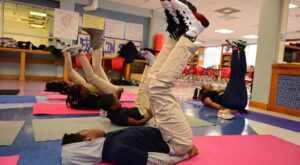
Interview with Sarah Norman and Ali Smith
As varied as the colors, textures, and patterns on a yoga mat can be, so are the stories of the people on those mats. From youth to seniors, Holistic Life Foundation’s Co-Founder, Ali Smith, is changing lives and communities through an evidence-based yoga and mindfulness program.
More than 200,000 students and adults in more than 100 schools and communities nationwide have learned about the transformative power that’s possible with a yoga and mindfulness practice.
Holistic Life Foundation brings its program to schools, recreation and senior centers, mental health facilities, and detention centers.
Their pilot study, conducted in partnership with Johns Hopkins University, Penn State, and the Baltimore School District, and published in the Journal of Abnormal Child Psychology, found improvements in students’ emotional regulation and stress response, as well as a reduction in rumination.

Courtesy: Holistic Life Foundation
With his Co-Founders and affectionately named “A-Team”, Ali and his brother, Atman Smith, and college friend, Andres Gonzalez, wrote a book about the capacity we all have to heal our hearts.
Ali Smith is an Advisor for BrainFutures and talked with our nonprofit’s Executive Director, Sarah Norman. Ali discussed the common thread that unites the people and communities across the diverse landscapes where he teaches, the growth and future of the Holistic Life Foundation, and lessons for any nonprofit seeking to collaborate with schools to enhance mental health and well-being.
Read the full Q&A with Sarah and Ali.
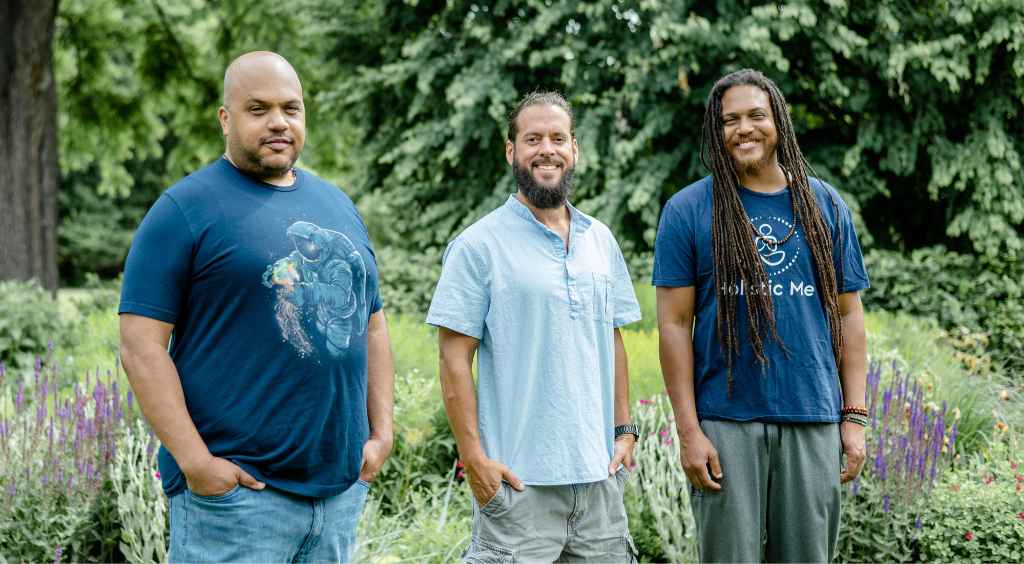
I don’t think we knew what to expect in that moment, because yoga’s popularity is a lot different from what it was in March of 2002.
I feel like yoga is now all over pop culture. There are yoga studios everywhere. Mindfulness is on the cover of magazines.
Back then, particularly in Baltimore, it wasn’t out there. So, I think we saw its effect on us, and we were like, well, let’s share this with some people.
A principal gave us the opportunity to coach football. We decided to start an after-school yoga program, and then we had theories about how well it would work.
I think it worked better than we thought it would once we got to the young people.
It definitely feels different. We don’t have to explain to people what we are doing. I think some of the minuses are that, like with everything, once it starts working, it gets watered down.
I think what separates us from many other resources is that the number one goal of the Holistic Life Foundation is to train authentic teachers. We have really good, embodied instructors who can go and relate to whether it’s kids in schools, adults in drug treatment centers, or even seniors in senior facilities.
We stress from the day we hire people to when we start training them, to our staff that’s been with us for a decade, the importance of having a personal daily practice.
You know from the way they’re responding to the work.
People working and teaching anything in traumatized and underserved communities is difficult. But when you’re teaching yoga and mindfulness, certain things are going to come up, and you’re going to start to take on certain things like that secondary trauma. It’s real, the weight of what you’re teaching and what’s being shared with you is real.
So, I think if you don’t have a practice, it’s going to run you off really quickly. You won’t be able to stick with it.
The people who have been with us for a while, the people who do have a personal practice, are taking the time to take care of themselves.

Courtesy: Holistic Life Foundation
We work in underserved schools, and we work in private schools. We work in both urban and rural schools. So, it’s all over the place.
I think the thing that’s consistent across all of them is the struggle, like an internal struggle is there for everybody, and the struggle between them and the people around them, and the struggle with them in the world is the one consistency.
The struggles look different, but nobody’s living in that perfect, seamless life where everything is rainbows and sunshine all the time. There’s going to be struggles.
So, I think the one thing that the after looks like is that people have skills and tools to deal with their struggles. They start to accept themselves and love themselves more, and that ripples out to them being more compassionate, empathetic, and empathetic to the people around them.
I think there are measures for that.
We were doing a lot of school-based measures, looking at suspensions, test scores, and attendance.
We’re working with Partnerships in Education and Resilience (PEAR). We saw some things that led us to believe that kids and adults in the building were getting some positive mental health outcomes from the program.
So we’re actually getting measures for that through PEAR around self-worth, self-love, depression, and anxiety. And using the practice outside of school.
We’re looking at a lot of different things that we can quantify to show our programs are working in ways that we see and hear about. But we want to get the numbers behind that.
Editor’s Note: Ali said they’re measuring 10 schools this year, starting with a baseline this fall.
There are always those really cool success stories of the kid that might have been on the wrong track, and they used the practice, and they got themselves back together. Then they graduated from college, and they’re doing all these wonderful things.
But it’s also those kids whose life circumstances are a little more difficult. There’s one young man from our first cohort who is currently incarcerated in Alabama. And you know, he and I stay in contact.
He sat for a long time without getting an opportunity to be sentenced or anything. It was eating at him because he was in a state of limbo, and he didn’t know what was going on. His breathwork and meditation practice were what kept him sane through all of that.
So, it works in different ways. I think the one thing that we do really well with is empowering people at the practice, so they know how to use it when we’re not around and when to use it.
We stay in contact, and his practice gets him through.

Courtesy: Holistic Life Foundation
The first thing is to develop a relationship with the principal. If the principal is not on board, the program will never succeed.
Then get the buy-in of the teachers. Show them through data, research, and experiential practices why this is important and why it’s a good use of time. Then we start working with the young people in the building.
Absolutely. You have to do it that way. Or it’ll never work.
We realized we really have to work with every single person in the building to shift the school culture.
Some people have more influence energetically over the building because of their position. If you can work with everyone, it just helps.

Courtesy: Holistic Life Foundation
Definitely would have a lot of outdoor green space where the kids can go out there to learn and just ground and interact with nature. They would grow their own food on location, I think, like, whether that’s a greenhouse, however it needs to be, they will grow their own food there.
There would be natural play spaces, no matter if the kids were in kindergarten or high school. The places where kids can go and have fun.
Rooms for mindful moments because everybody needs a break. Ideally, there’ll be one for the students and one for the teachers.
I think there would be natural light in the school. No overhead fluorescent lights. None of that.
I think a lot of care around grouping kids with their learning style, because not everyone learns the same way.
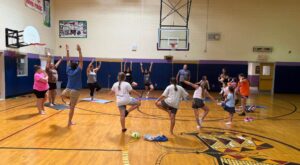
St. Regis Mohawk School in the Akwesasne Mohawk Territory | Courtesy: Holistic Life Foundation
I think working on scaling that program and getting into some district-wide situations, because it helps with many different things, and getting more out into the community.
We’re working with Healing Cities to work with the firefighters and first responders. We want to do more of that work.
We’re doing studies on our work in senior centers and drug treatment facilities in hopes of doing more of that.
I think another one of our goals is our certification program to get that out there to as many people as possible. We can’t do everything, but if we can train people to really teach in a trauma-informed, trauma-responsive, and trauma-healing way, then that can help to change the world without us even having to be there.
We want to do another satellite program. We have a satellite location up at Akwesasne, up at the Mohawk Reservation. We want another satellite location in a more urban environment. So, we have some places we’re looking at, and that’ll be something else.
Editors Note: The satellite locations work with first responders, and have a community focus, in addition to the school.
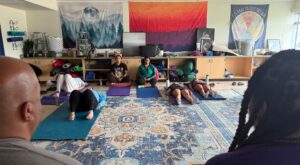
Workforce development session at Akwesasne Mohawk Territory | Courtesy: Holistic Life Foundation
So Milwaukee, we’re just doing programs in some of the schools. We’ve have three schools, a high school and two K-8 schools.
Our actual satellite location up at Akwesasne, we have a program director up there. We have staff who are teaching in the schools and out in the community. We provide all administrative, programmatic, and training support.
I’d say my meditation practice. Me, my brother, and Andy’s teacher, was one of those people that when we first asked him to teach us, he pretty much told us, like, ‘I’m not teaching you guys to be students. I’m teaching you guys to be teachers. I’m teaching you so you can go out and share this with the world.’
So, I think when I meditate, it’s just a reminder of, I have to make the change within myself, and I can show other people how to make the changes inside of themselves, because you can’t really change or save anybody.
I think it’s just that whole reminding yourself and reminding the people that you’re working with that the true change is going to become when you connect with that that spark inside of you, and then kind of feed off of that, rather than your thoughts or your worries or your doubts or your fears. That’s where true change happens.
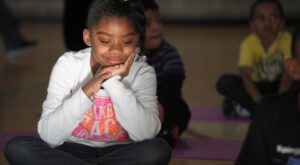
Courtesy: Holistic Life Foundation
With my boys, their meditation practice is different than mine.
We would sit, we would talk about spirituality, and like the earth and their connection to the universe and things around spirituality. And then I would listen to them, and then we form their practice around that so they have their own practice.
I know, when my brother and I practiced with our dad, we were a part of his practice. But when he stopped practicing, our practice stopped because we didn’t really know what to do.
So, with them, it was more about helping them build their own practice in a way that was fun to them and spoke to them. And a way they would always go back to.
My brother and I have talked about this a lot! It has to be something we do outside of the Holistic Life Foundation.
Doing a study on deeply spiritual forms of meditation. We have a feeling that it does a lot more for the body and the mind than awareness practices.
Connect with Ali Smith
Connect with Holistic Life Foundation